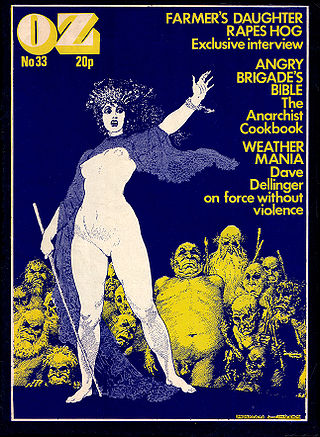
The terms underground press or clandestine press refer to periodicals and publications that are produced without official approval, illegally or against the wishes of a dominant group. In specific recent Asian, American and Western European context, the term "underground press" has most frequently been employed to refer to the independently published and distributed underground papers associated with the counterculture of the late 1960s and early 1970s in India and Bangladesh in Asia, in the United States and Canada in North America, and the United Kingdom and other western nations. It can also refer to the newspapers produced independently in repressive regimes. In German occupied Europe, for example, a thriving underground press operated, usually in association with the Resistance. Other notable examples include the samizdat and bibuła, which operated in the Soviet Union and Poland respectively, during the Cold War.
Liberation News Service (LNS) was a New Left, anti-war underground press news agency that distributed news bulletins and photographs to hundreds of subscribing underground, alternative and radical newspapers from 1967 to 1981. Considered the "Associated Press" for the underground press, at its zenith the LNS served more than 500 papers. Founded in Washington, D.C., it operated out of New York City for most of its existence.

The Oracle of the City of San Francisco, also known as the San Francisco Oracle, was an underground newspaper published in 12 issues from September 20, 1966, to February 1968 in the Haight-Ashbury neighborhood of that city. Allen Cohen (1940–2004), the editor during the paper's most vibrant period, and Michael Bowen, the art director, were among the founders of the publication. The Oracle was an early member of the Underground Press Syndicate.
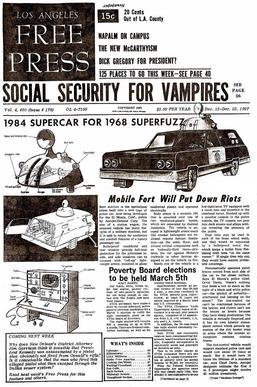
The Los Angeles Free Press, also called the "Freep", is often cited as the first, and certainly was the largest, of the underground newspapers of the 1960s. The Freep was founded in 1964 by Art Kunkin, who served as its publisher until 1971 and continued on as its editor-in-chief through June 1973. The paper closed in 1978. It was unsuccessfully revived a number of times afterward.

The Berkeley Barb was a weekly underground newspaper published in Berkeley, California, during the years 1965 to 1980. It was one of the first and most influential of the counterculture newspapers, covering such subjects as the anti-war movement and Civil Rights Movement, as well as the social changes advocated by youth culture.

The Great Speckled Bird was a counterculture underground newspaper based in Atlanta, Georgia from 1968 to 1976 and 1988 through 1990. Commonly known as The Bird, it was founded by New Left activists from Emory University and members of the Southern Student Organizing Committee, an offshoot of Students for a Democratic Society. Founding editors included Tom and Stephanie Coffin, Howard Romaine and Gene Guerrero Jr. The first issue appeared March 8, 1968, and within 6 months it was publishing weekly. By 1970 it was the third largest weekly newspaper in Georgia with a paid circulation of 22,000 copies. The paper subscribed to Liberation News Service, a leftist news collective. The office of The Great Speckled Bird at the north end of Piedmont Park was firebombed and destroyed on May 6, 1972. In a letter to the editor of the New York Review of Books, Jack Newfield et al. note that the bombing occurred after the paper published an exposé of the mayor of Atlanta.
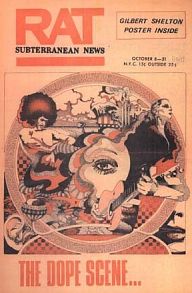
Rat Subterranean News, New York's second major underground newspaper, was created in March 1968, primarily by editor Jeff Shero, Alice Embree and Gary Thiher, who moved up from Austin, Texas, where they had been involved in The Rag.
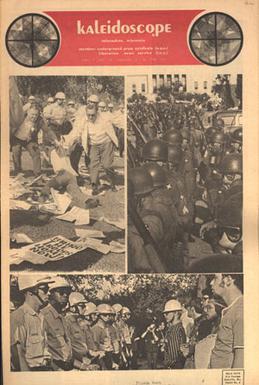
Kaleidoscope was an underground newspaper that was published in Milwaukee, Wisconsin, USA]. Founded by John Kois, the radio disk jockey Bob Reitman and John Sahli, it was published from October 6, 1967, to November 11, 1971, printing 105 biweekly issues. The paper's first issue was printed with a borrowed $250 in an edition of 3,500 copies, which sold out in two days.

The Chicago Seed was an underground newspaper published biweekly in Chicago, Illinois from May 1967 to 1974; there were 121 issues published in all. It was notable for its colorful psychedelic graphics and its eclectic, non-doctrinaire radical politics. Important events covered by Seed writers and artists were the trial of the Chicago Eight, Woodstock, and the murder of Fred Hampton. At its peak, the Seed circulated between 30,000 and 40,000 copies, with national distribution.
The Columbus Free Press is an American alternative journal published in Columbus, Ohio since 1970. Founded as an underground newspaper centered on anti-war and student activist issues, after the winding down of the Vietnam War it successfully made the transition to the alternative weekly format focusing on lifestyles, alternative culture, and investigative journalism, while continuing to espouse progressive politics. Although published monthly, it has also had quarterly, bi-weekly and weekly schedules at various times in its history, with plans calling for a return to a weekly format by the end of 2014.
Inquisition v. City of Charlotte was a landmark First Amendment Supreme Court decision.
The Southern Student Organizing Committee (SSOC) was a student activist group in the southern United States during the 1960s, which focused on many political and social issues including: African-American civil rights, opposition to the Vietnam War, worker's rights, and feminism. It was intended, in part, to be SDS for Southerners and SNCC for white students – at a time when it was dangerous for SDS to attempt to organize in the Deep South and when SNCC was starting to discuss expelling white volunteers. It was felt that students at the traditionally white and black colleges in the South could be more effectively organized separately than in an integrated student civil rights organization; however, this was controversial and initially opposed by advisors like Anne Braden. Sue Thrasher and Archie Allen of the Christian Action Fellowship were among the founders of the group, with the support of Bob Moses and others. At its inception, the group had close ties to controversial Louisville, Kentucky radicals Carl and Anne Braden and their organization, the Southern Conference Education Fund, but a deliberate effort was later made to put some distance between the SSOC and the Bradens to avoid the appearance that the SSOC was a Communist front.

Quicksilver Times was an antiwar, counterculture underground newspaper published in Washington, DC. Its first issue was dated June 16, 1969, with Terry Becker Jr., a former college newspaper editor and reporter for the Newhouse News Service, the main instigator in the founding group of antiwar activists. It ran for 3 years, with its final issue appearing in Aug. 1972. Publication was irregular and during the latter part of its run it was publishing once every 3 weeks. It was a member of the Liberation News Service and the Underground Press Syndicate. Quicksilver Times was one of several anti-government underground papers of the period now known to have been infiltrated by government informants.
Willamette Bridge was an underground newspaper published in Portland, Oregon from June 7, 1968 to June 24, 1971. In the spring of 1968, several groups of people in Portland were discussing starting an "underground" newspaper in Portland, similar to the Los Angeles Free Press or the Berkeley Barb. They were partially motivated by a frustration with the reporting in the mainstream press, which was still supporting the Vietnam war, opposing progressive movements like the United Farmworkers Union, and showed no understanding at all of the growing "Counterculture" and its music, dress and mores. On the other hand, they saw many things going on in the city that were positive, but isolated- Antiwar activity at Reed College, "Hippies" gathering around Lair Hill park, the progressive wing of the Democratic Party gathering strength, craft stores and head shops opening around town, local bands like The Great Pumpkin and The Portland Zoo giving concerts. A newspaper could bring these groups together and break the information monopoly of the daily papers.

The Northwest Passage was a bi-weekly underground newspaper in Bellingham, Washington, which was published from March 17, 1969 to June 1986. The paper was co-founded by Frank Kathman as publisher, Laurence Kee as Managing Editor, and Michael Carlson as Art Director. The newspaper was primarily known for its graphic design content.
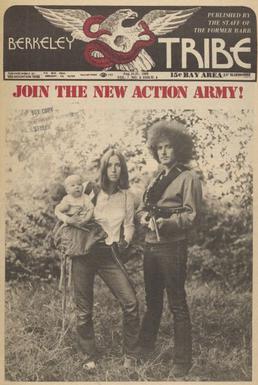
The Berkeley Tribe was a radical counterculture weekly underground newspaper published in Berkeley, California from 1969 to 1972. It was formed after a bitter staff dispute with publisher Max Scherr and split the nationally known Berkeley Barb into new competing underground weeklies. In July 1969 some 40 editorial and production staff with the Barb went on strike for three weeks, then started publishing the Berkeley Tribe as a rival paper, after first printing an interim issue called Barb on Strike to discuss the strike issues with the readership. They incorporated as Red Mountain Tribe, named after Gallo's one gallon finger-ringed jug of cheap wine, Red Mountain. It became a leading publication of the New Left.

Spokane Natural was an underground newspaper published biweekly in Spokane, Washington from May 5, 1967 to November 13, 1970, by the Mandala Printshop, and edited by Russ Nobbs. It belonged to the Underground Press Syndicate and the Liberation News Service. The first issue was produced out of a converted barbershop storefront cum bookstore and hangout called the "Hippie Mission" on a cul-de-sac in Spokane, where Russ Nobbs and a visiting friend from the SF Bay area, Ormond Otvos wrote and produced the first 8 page issue on a hand-cranked Spirit duplicator. After several issues of pale blue "Ditto" print on white paper, The Natural moved to colored papers and occasionally colored ink with a Gestetner Mimeograph duplicator. Ultimately, the newspaper was printed on newsprint by sheet fed or web presses by various printers in Spokane, Seattle and Davenport, WA.

Hundred Flowers was an underground newspaper published in Minneapolis, Minnesota from April 17, 1970 to April 4, 1972. It was produced by a communal collective, with the main instigator being antiwar activist and former Smith College drama instructor Ed Felien. The 16-page, two-color tabloid was published weekly and cost 25 cents, circulating about 5,000 copies.
The San Diego Free Press was an underground newspaper founded by philosophy students of Herbert Marcuse at the University of California, San Diego in November 1968, and published under that title biweekly until December 1969, when it became the weekly Street Journal starting with its 29th issue. The paper's contents were a mix of radical politics, alternative lifestyles, and the counterculture, reflecting in part Marcuse's Frankfurt School Marxist/Freudian ideas of cultural transformation.

Old Mole was a radical New Left oriented underground newspaper published in Cambridge, Massachusetts from September 1968 to September 1970. Old Mole was continued by a second volume titled The Mole, which published five issues from November 1970 to April 1971. Printed biweekly in a 16-page tabloid format, Old Mole was based for most of its existence in a storefront and basement office on Brookline Street in Central Square. Selling for 15 cents, 47 issues were published in all, with press runs averaging 8000 to 10,000 copies. Subscriptions were free to prisoners and soldiers.














